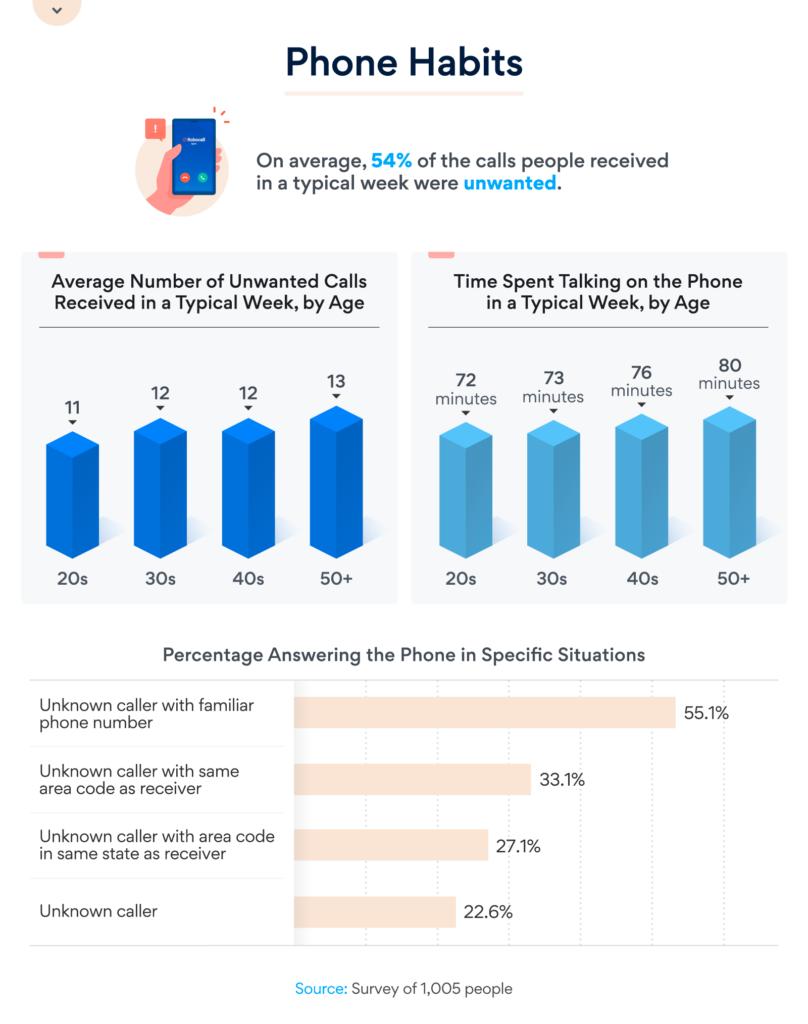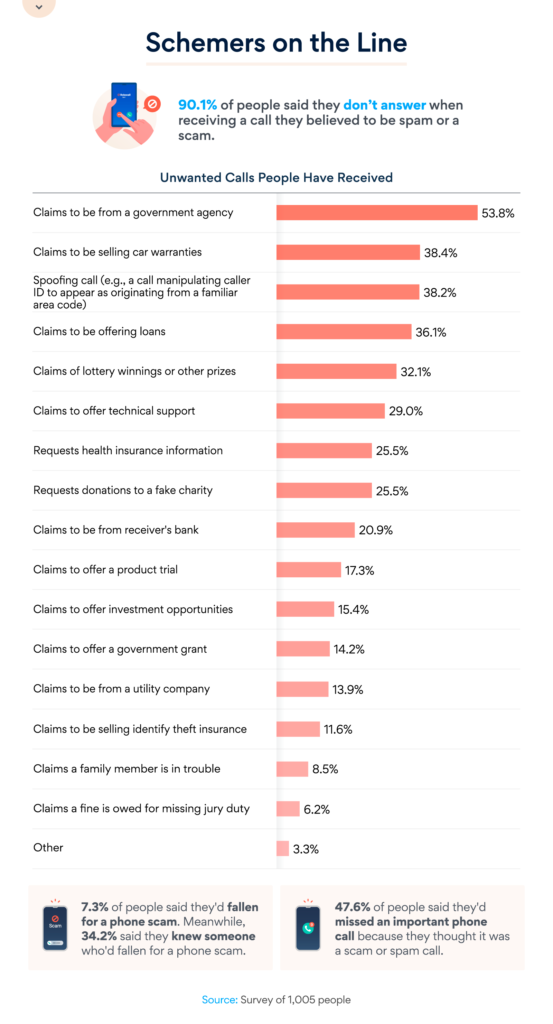
The ways in which cellphones and smartphones have impacted our society are almost impossible to measure. With increased accessibility to information and ease of communication, people have been able to make connections that would have been unimaginable to past generations.
Despite the advantages that phones can bring to our life, they may also create opportunities for invasive spammers or scammers to reach out relentlessly. Oftentimes, these calls are classified as “robocalls” or unwanted calls, with the expressed mission of plaguing voicemail boxes with threatening or fraudulent messages.
To find out more about how unwanted calls are affecting anyone with a phone number or email address, we surveyed more than 1,000 people to gather the experiences of the masses. Read on to find out how often the average American deals with unwanted phone calls and how they choose to tackle the problem.
Older Americans at Slightly Higher Risk for Unwanted Calls

Dealing with unwanted calls can be difficult to manage considering the sheer scale of this problem: Respondents reported that an average of 54% of the calls they received in a given week were uninvited. People aged 50 and older reported the most unwanted calls.
Although many of our respondents admitted to answering the phone if the number looked familiar (55%) or shared their area code (33%), the Federal Trade Commission (FTC) recommends disconnecting the call if you’ve answered and adding the number to your blocked list. These types of unwanted callers willingly disregard do not call lists and are continuously seeking new ways to prey on vulnerable people.
As talking on the phone has become a less essential part of society, people have started developing anxiety around doing so when necessary. The chance of a nefarious stranger being on the other line doesn’t increase people’s desire to talk on the phone.
Who’s on the Other Line?

When a phone phobia manifests itself, someone is less likely to trust or want to talk to whomever is on the other line. As a result of this stress, people can miss important calls or news because a call stems from an unknown number. If you’re cautious about a particular number, it’s OK to let the call go to voicemail and address it later.
Unfortunately, it’s common for unwanted callers to impersonate trusted members of the community to lie about some type of critical alert regarding security, safety, or well-being: 53.8% of people reported getting a scam call where the caller claimed to be from a government agency like the IRS or an affiliated organization. The IRS has repeatedly warned citizens about these common scams reaffirming they’ll never call a consumer on the phone regarding their IRS details or sensitive information.
Following government agency calls, the other most popular types of calls that respondents reported receiving were regarding car warranties (38%), “spoofing” calls disguised with a familiar area code (38%), fake loan officers (36%), and fraudulent lottery winnings (32%). Regardless of the scam, most people claim to be on top of protecting themselves: Only 7% of respondents said they’d fallen for a phone scam, but over 34% claimed to know someone who had fallen victim to a scam caller.
How to Halt Unwanted Callers in Their Tracks

There are many tactics that people reported employing to mitigate the number of unwanted calls getting through and interrupting their lives. The most common tactic involved using the blocking features built into their phones to keep suspicious-looking calls at bay. This method proved to be popular among roughly 54% of respondents, followed by adding their phone number to the National Do Not Call Registry (42%) and using their cell service provider to block unwanted numbers (31%).
According to survey participants, the most effective means of detecting and dispelling unwanted callers is to use the “Do Not Disturb” mode to only allow calls from known personal contacts. These exceptions are designed to let users create custom allowances for incoming calls. Additionally, new smartphone capabilities, such as embedded auto-scan and block features, are attempting to bring an end to resilient unwanted callers.
How Unwanted Calling Has Affected Communication

Robocalls, spam messages, and scammers who can directly contact people have changed how we react to phone calls: Over 3 in 4 people said they answer the phone less often than they did five years ago. Although text messaging, social media messaging apps, data-based calling like WhatsApp, and encrypted messaging platforms like Signal have largely replaced verbal phone calls for many Americans, the epidemic of unwanted calling has likely made an impact as well.
By far, most survey participants said they prefer texting to any other form of communication, favored by nearly 60% of people between 20 and 49 years old. In recent years, younger generations have stayed away from phone calls like the plague, even though they can offer a more personal interaction compared to text messages.
Take Steps to End Unwanted Calls
No one enjoys having an unwanted call come in and being forced to step away from a social gathering or important meeting. The best way to protect yourself against these schemes is to be aware of the FBI, FTC, and other government agencies’ efforts to reduce the scope of unwanted callers.
Feeling overwhelmed with unwanted calls? Fret not: Robo Shield and our unwanted call detection technology allow users to take back their free time and peace of mind with integrations designed to keep your phone, hot spot, passwords, and identity safe. Download the app today and start feeling relief immediately.
Methodology
We surveyed 1,005 people about their experiences with unwanted cellphone calls. Respondents were 53% women and 47% men. The average age of respondents was 38.2 with a standard deviation of 12.
Respondents were asked to report how many total calls they received on their cellphone in a typical week and the number of unwanted calls (e.g., spam or scam calls) they received in a week. These two numbers were averaged across all respondents to find the percentage of unwanted phone calls people typically received in a week.
People were asked to report how many minutes they spent talking on the phone in a typical week, on average. These averages were calculated to exclude outliers. This was done by finding the initial average and standard deviation. The standard deviation was then multiplied by three and added to the initial average. Any data point above this sum was then excluded.
People were asked to report any scam calls they had received before. They were able to check all options that applied to them. Therefore, percentages may not add to 100 for this information. The same is true of the reported actions people took to reduce the number of unwanted calls received.
Limitations
This project relies on self-report. Common issues with self-reported data include exaggeration and selective memory. For example, respondents could have exaggerated the amount of time they spent talking on the phone in a typical week, skewing the calculated averages.
Fair Use Statement
No one wants to be beset by unwanted phone calls. If someone you know would find the information in this project useful, you are free to share for any noncommercial reuse. Please be sure to link back here, so the study can be viewed in its entirety and people can review the methodology. This also gives credit to our contributors for their efforts.


